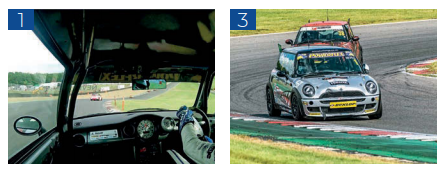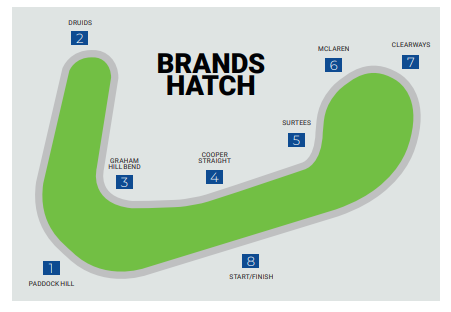Brands Hatch Indy Circuit
PERFORMANCE MINI’S RESIDENT RACER TELLS US HOW TO GET THE FASTEST LAP TIMES AROUND HIS HOME CIRCUIT.
Brands Hatch is my local circuit and therefore a favorite of mine. It’s also where I do most of my instruction work, so I hope I know what I’m talking about in this guide! The Indy circuit is one of the shortest tracks in the UK at just 1.1 miles. It looks fairly simple, but what it lacks in quantity is more than made up in the quality of the corners; Paddock Hill is known around the world, and the technical challenges of Graham Hill and Clearways are unmatched at any other track in the country.
It features short ‘straights’ and tricky corners, which makes it perfect for a MINI!
THE KEYS TO BRANDS HATCH INDY CIRCUIT
■ Take time to build up your confidence and temperature: Brands Hatch isn’t the most forgiving of circuits, with the potential for big damage bills at most of the corners. As we’ve talked about before, lift-off oversteer is what’s most likely to put you off track in your MINI, so take the time to build your confidence and corner speed before pushing on too hard. The same applies to your tire temperatures, pushing too hard on cold rear tires could have similar consequences.
■ Focus on your lines: we’ll cover this in more detail as we work through each corner but this is a circuit where your average track day driver usually struggles a bit with their racing lines, mainly due to the elevation changes around the circuit and the slightly ‘odd’ challenges that it presents in places. If you’re on a track day, using the apex cones around the circuit will really help here.
■ Keep your wits about you: given it’s a short lap you’ll notice more traffic around you than at some other circuits, and as there aren’t any particularly long straights it’s also harder for a more powerful car to get past here than it would be at a circuit like Snetterton for example. If you’re on a track day make sure you’re aware of the traffic around you, as it will bunch up a lot more than at a longer circuit.
#1 – PADDOCK HILL
The lap starts in the best possible way, with Paddock Hill bend. It’s one of the best corners in the world, and incredibly rewarding when you get it right. You should be positioned on the left-hand side of the circuit before you brake; there’s a crest just after the start/finish line and it’s a good reference point.
In race cars, we don’t start braking until a few meters after the crest, but I wouldn’t recommend that for your first time! Start by braking just after the start/finish line and then as you build your confidence on each lap, start to shorten your braking distance and get a feel for what your car and brakes are capable of, as well as what you’re comfortable with. Take some time to familiarise yourself with the bumps and camber changes in the braking zone here, as they can make the car slightly unstable whilst you brake.
Your turn-in point for the corner is the start of the gravel trap to the driver's left (after the access road), from here you’ll find the apex quite naturally. It’s absolutely essential that you are fully committed to the corner by the time you reach the apex. With the way the circuit drops away so suddenly at the apex, all of the weight of the car will be at the front and the rear is even lighter than usual.
Any lift-off oversteer generated here will only be saved by luck, and the same applies if the rear tires are too cold.
Make sure you arrive at the apex at a speed you know you can carry through the corner, and once you’re there get back onto the throttle hard (the weight being on the front wheels means you’ll have more grip on them than usual) and run the car out to the kerb to the left of the circuit.
#2 - DRUIDS
Up next is the Druids. I use the footbridge running over the circuit here as my reference point for both my braking and my turning, hitting the brakes hard as I go under the bridge and gently starting to turn towards the corner at the same time. That sounds very early to be turning, but the camber of the corner means you can do this and still roll in with quite a bit of corner speed, has also shortened the distance the car is traveling by cutting into the corner so soon.
The inside of this corner was re-surfaced a couple of years back and provides more grip than the older bits of tarmac, which also helps make this tighter line work.
Once you’re into the corner you have two options; you can either roll through and hug the white line on the inside (but don’t touch the kerb) all the way through the corner, or you can square the corner off into a ‘V’ shape. To do this, you turn in at the same point but then allow the car to run out slightly wide around the middle of the corner before turning back into the corner. It’ll make you straighter on the exit which will help you put the power down, but you’ll have lost speed mid-corner compared to holding the car on the tighter line.
#3 – GRAHAM HILL BEND
After running out to the left-hand side at the exit of Druids, the next job is to set the car up for Graham Hill Bend. This is a corner that a lot of track day drivers struggle with, but it's also the second most important corner on the circuit as it leads onto the second longest straight (which still has a slight curve in it).
To start with, the car needs to be moved.
over from the exit kerb on drivers left out of Druids back over to the right-hand side of the circuit.
There’s a kink in the road just before the corner, which is also the start of the braking zone. Turn into the kink slightly to shorten your distance, but only back to the middle of the track as a maximum as you need to be braking in a straight line.
Most drivers here will turn in too early, which costs them a lot of time on the exit.
Personally, I like to wait until I can see my line through the corner (all the way to the exit) before I turn in. Don’t be afraid to use a bit of kerb, and once the car is on target for the apex start to apply the throttle.
Remember that the exit of the corner here is crucial as it dictates how much speed you carry into Cooper Straight.
#4 – COOPER STRAIGHT
There’s not much to say about the Cooper Straight that follows, apart from there is a kink about halfway down that you’ll want to cut back towards the middle of the circuit for. It’ll make a minute difference to your lap time, but it does shorten the distance you travel and it’s, therefore, an easy time to gain.
#5 – SURTEES
The second half of the lap begins with Surtees, followed immediately by McLaren.
Both are easily flat in our MINI CHALLENGE Coopers, but without race tires or suspension, you may find you need either a slight lift (enough to slow the car but not enough to drastically change its balance) or a dab of the brakes before you turn.
Like with Graham Hill bend, you want a late apex here, so that you can go straight from the apex to the inside of McLaren. A lot
of drivers use the kerb on the inside here, but personally, I find it’s faster in the MINI to avoid it. If you are going to use it just bear in mind that it will make the car unstable, and if you don’t hold your nerve at that point you’re going to visit the Medical Centre.
That’s not me being overly dramatic – you’ll spin to the inside and hit the wall right where the medical center is located!
#6 - MCLAREN
McLaren itself isn’t really a corner. As long as your line through Surtees has been correct then you won’t need to turn into it, the car should naturally go to the inside of it from the apex of Surtees. Then, as you want to be on the left of the circuit for Clearways you just need to let the car run back out to that side of the circuit.
#7 - CLEARWAYS
Clearways is the most important corner on the circuit and also the one that drivers tend to struggle with the most. A lot of drivers use a really late apex and hug the right-hand side of the circuit on the exit. That’s not only slow on the entry (as they’re waiting for the apex to accelerate) but it’s also slow on the exit as the car is being held tighter to the inside and therefore not able to accelerate as it would if you use all of the roads.
Your apex is the point of the inside curb where it starts to widen, keep tight to the curb and start to feed in the power smoothly until the elevation starts to drop away, by which point you want to be hard on the throttle and the car will naturally run out to the outside of the circuit.
It makes a significant difference to use this line because you'll be at full throttle before drivers who are using the incorrect line have even reached their apex.
#8 START/FINISH LINE
From there it’s back onto the front straight, where you’ll see a slight curve just after the start of the pit wall on the right. Gently turn towards it and keep tight to the pit wall all the way to the finish line – but remember to move the car back to the left to set yourself up for Paddock Hill again. And that’s a lap!



Comments
Post a Comment